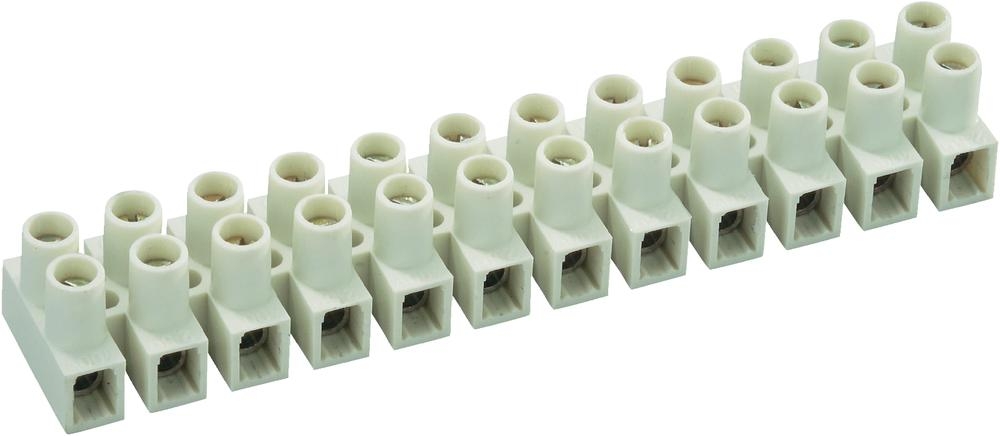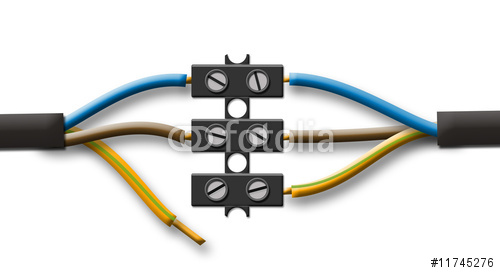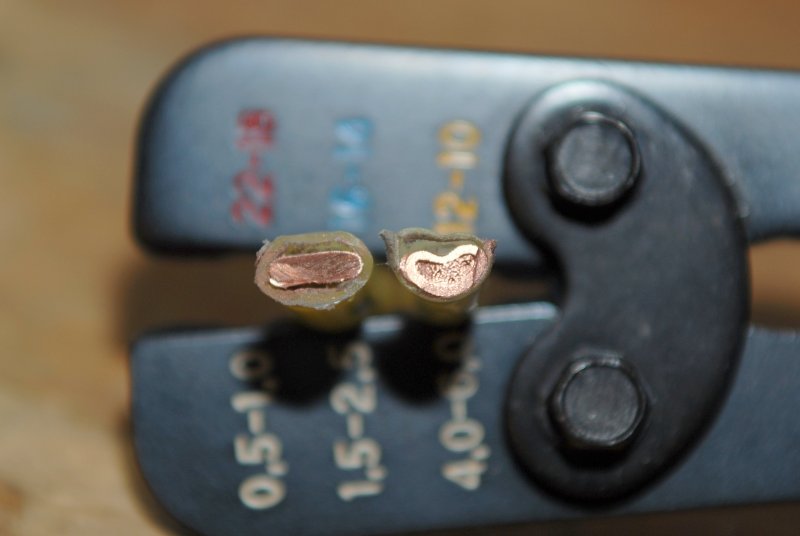In a high vibration application, in moist conditions, what is the best way to splice wiring?
I cannot solder.
I have little faith in,crimped connectors.
Is there a better way?
Full Version: Wiring question
In a high vibration application, in moist conditions, what is the best way to splice wiring?
I cannot solder.
I have little faith in,crimped connectors.
Is there a better way?
Why is it you can't solder? It is for sure the best way to splice. Solder then heat shrink to cover it. If you have to, practice on something else, but there is no better way. As for crimped connectors, I agree, very little faith. Soldering is sometimes tricky with old crusty wiring, but a little flux and the right solder and all is well.
Solder is only good for secure electrical connections. It should not be used to hold wires together.
Get the crimp connector, take off the plastic insulation. Slide the crimp on the wire. Also slide on a piece of shrink wrap.
Twist the wires together. Slide the crimp over the twisted wires and crimp. Solder the whole thing. Then slide the shrink wrap on the crimp and heat. Cover the shrink wrap with water resistant RTV.
Get the crimp connector, take off the plastic insulation. Slide the crimp on the wire. Also slide on a piece of shrink wrap.
Twist the wires together. Slide the crimp over the twisted wires and crimp. Solder the whole thing. Then slide the shrink wrap on the crimp and heat. Cover the shrink wrap with water resistant RTV.
A set of Lüsterklemmen will give you a good connection that can withstand vibration and can be used in a moist environment by using shrink wrap or electrical tape.





If you've got good equipment, crimping can be more secure than soldering. The good stuff ain't cheap, and the cheap stuff ain't good, though.
--DD
--DD
Wiring experts say that the process of soldering will make the splice rigid and thus susceptible to vibrations which can create an open circuit. Properly crimped connections maintain flexibility and are thus preferred.
Sherwood
Sherwood
Not all soldering is equal, though. Some solder joints are acceptable (or required!) in aerospace applications as well! But there are some pretty stringent requirements about the results. Probably beyond the skill (or at least knowledge) of most of us, though.
--DD
--DD
In a high vibration application, in moist conditions, what is the best way to splice wiring?
I cannot solder.
I have little faith in,crimped connectors.
Is there a better way?
Duraseal connectors are good and waterproof,crimp on and shrink with a heatgun.
Crimp connectors are only as good as the tool that crimps them,forget the cheap tools they don't crimp the connector to the wire properly.
Soldering is a matter of practice to get right,you get better as you go along,the secret is to have clean wire and a good hot soldering iron,I don't personally like the chocolate block connectors and won't put them near my car.
Heatshrink is ok over a soldered joint but must be the right size,I have found that the internally clued type is the only one that is waterproof.
In the Marine Corps we used solder crimps with built in shrink tube. They work great in jet fighters and heilos.
They don't contain much solder and the shrink tube supports the wire so the joint will not flex and break.
They don't contain much solder and the shrink tube supports the wire so the joint will not flex and break.
Usually in Aerospace we solder then pot it. Or what mike talked about.
I forget the product name but as with anything its not cheap.
Generally pep boys water proof heat shrink crimp connects work really well for most applications.
depends on what you are doing and how dedicated you want to be.
I forget the product name but as with anything its not cheap.
Generally pep boys water proof heat shrink crimp connects work really well for most applications.
depends on what you are doing and how dedicated you want to be.
How about instead of dozens of connectors I use a water proof plug.
Something in range of 10-20 different connections.
Where would I find those?
Something in range of 10-20 different connections.
Where would I find those?
Here is the commercial version of out military solder crimp...
https://www.youtube.com/watch?v=BmZ8Ry99TMs
Similar product...
https://www.youtube.com/watch?v=24FjjIVpk9U
https://www.youtube.com/watch?v=BmZ8Ry99TMs
Similar product...
https://www.youtube.com/watch?v=24FjjIVpk9U
Marine Corps sent me to a week long solder school similar to this... Thing is, I already knew how to solder... 
https://www.youtube.com/watch?v=xPkc6k5uWUQ
https://www.youtube.com/watch?v=xPkc6k5uWUQ
Nope, it's true.
Must admit that the tools I have suck.
My buddy has an industrial soldering iron with a big box, I actually did solder with that...
I cannot sweat a plumbing connection to save my life.
The new pex tubing and connectors opened a whole new world to me for plumbing.
I cannot sweat a plumbing connection to save my life.
I call
3 keys to soldering wires or pipes:
1) Make sure everything is clean
2) Use flux
3) Proper heat
For plumbing, the fourth key is no water in the pipes.
Most solder issues involve not enough heat. When properly heated, the items will suck solder in. If you have to push on the solder then it's not hot enough.
How about instead of dozens of connectors I use a water proof plug.
Something in range of 10-20 different connections.
Where would I find those?
For that many connections I would consider a power distribution block.
Lots of good stuff here
http://catalog.bluesea.com/#90
Are you working on a mars lander or something? It's a car for cripes sake! Strip of 1/4 inch of insulation on each end, push them in a splice and crimp them.
Are you working on a mars lander or something? It's a car for cripes sake! Strip of 1/4 inch of insulation on each end, push them in a splice and crimp them.
Boat, and there are two engines, and lots of sensors.
The DAPO replaced everything with RED wire, I guess it was all he had.
So......I will most likely terminate two harnesses about 4 feet away from the engines and build harnesses like our cars, just dedicated to the motor for all the sensors.
He used crimps, they don't work in high heat, high vibration, salt water etc....it's ugly doing forensics on this stuff, it does not last in,that environment.
And I admit, I hate plumbing.
I will never admit to knowing how to do plumbing.
Good crimps should outlast most anything. A good crimp (typically made with nice ratcheting crimpers, see Paladin Crimp-All as an example) cold welds the wire stands and pin together resulting in an environmentally secure connection without the brittleness at the insulation joint associated with soldering. The PO of your boat likely poorly crimped everything with no fusion of strands so corrosion in the salt and hot environment happens pretty readily.
You can see the difference between good and bad (but not terrible) crimps in this picture. The one on the left is totally fused while you can see stranding on the right side which will let air in and corrosion start.

I like to buy non-insulated terminals and then add adhesive heat shrink to them to add another level of strain relief and environmental protection to the connection. It also looks a little neater (IMHO) having single color terminals throughout the entire loom.
The solder splices Mike posted above are really nice though. I like using them for putting drain wires on shielded cables which do not have drains.
This website has a bunch of interesting articles on marine wiring.
http://www.pbase.com/mainecruising/wire_te...tion&page=1
You can see the difference between good and bad (but not terrible) crimps in this picture. The one on the left is totally fused while you can see stranding on the right side which will let air in and corrosion start.

I like to buy non-insulated terminals and then add adhesive heat shrink to them to add another level of strain relief and environmental protection to the connection. It also looks a little neater (IMHO) having single color terminals throughout the entire loom.
The solder splices Mike posted above are really nice though. I like using them for putting drain wires on shielded cables which do not have drains.
This website has a bunch of interesting articles on marine wiring.
http://www.pbase.com/mainecruising/wire_te...tion&page=1
Are you working on a mars lander or something? It's a car for cripes sake! Strip of 1/4 inch of insulation on each end, push them in a splice and crimp them.
Boat, and there are two engines, and lots of sensors.
The DAPO replaced everything with RED wire, I guess it was all he had.
So......I will most likely terminate two harnesses about 4 feet away from the engines and build harnesses like our cars, just dedicated to the motor for all the sensors.
He used crimps, they don't work in high heat, high vibration, salt water etc....it's ugly doing forensics on this stuff, it does not last in,that environment.
And I admit, I hate plumbing.
I will never admit to knowing how to do plumbing.
Yikes! Maybe a mars lander would be easier to deal with. Sounds like a difficult and time consuming job. Maybe this will help? http://www.bestboatwire.com/marine-electri...lti-wire-crimps
So,
With lots of smart people doing EFI systems, does anyone have a good suggestion for waterproof plugs of various sizes?
With lots of smart people doing EFI systems, does anyone have a good suggestion for waterproof plugs of various sizes?
Connectors are supplied by harness guys and panel builders for convienience, not because they are the best sulution for vibration and corrosion. I still think hard wiring an SO or SJO cord set to a power distribution block is your best bet.
If you do want to look at good stuff, look at machine tool and mining connectors, start with companies like Brad Harrison, they do a molded multi conductor series of weatherproof and oil resistant SO pig tail connectors
If you do want to look at good stuff, look at machine tool and mining connectors, start with companies like Brad Harrison, they do a molded multi conductor series of weatherproof and oil resistant SO pig tail connectors
What does SO and SJO stand for?
Flexible Power cord multi conductor.
Click to view attachment
Oil resistsnt, flexible, Brad Harrison and Wiremold mold weatherproof connectors to it
Click to view attachment
Oil resistsnt, flexible, Brad Harrison and Wiremold mold weatherproof connectors to it
This is a "lo-fi" version of our main content. To view the full version with more information, formatting and images, please click here.
